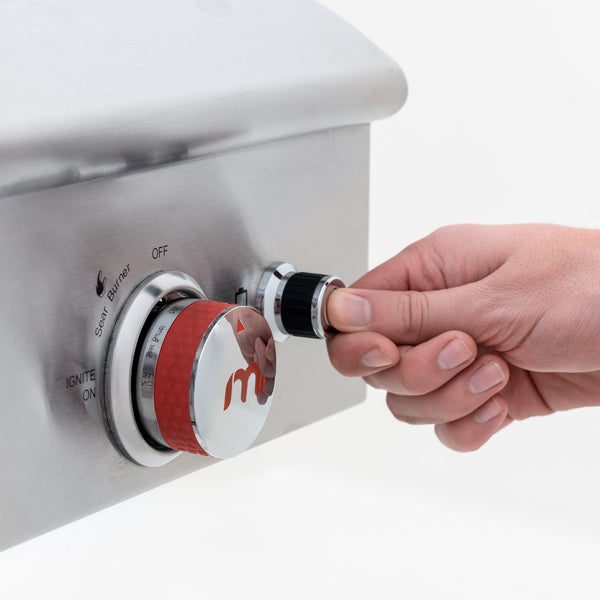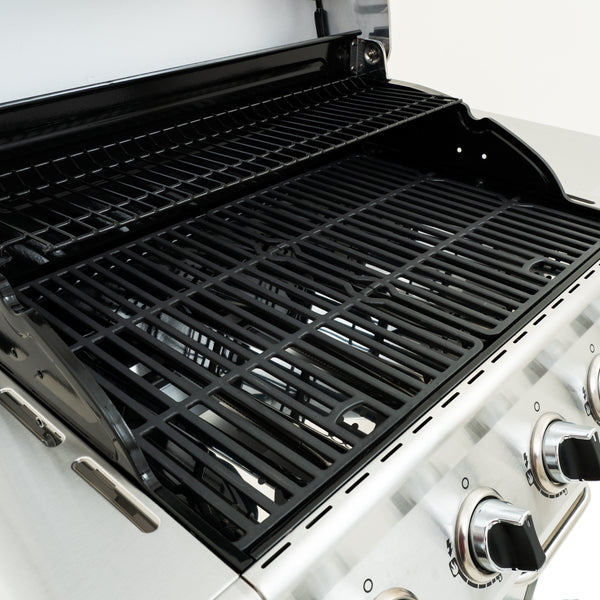Why is Your Gas Grill Regulator Not Working? (And How to Fix a Broken Regulator)
What Does The Regulator On A Gas Grill Do?
A gas grill regulator connects to your propane tank valve and controls the gas flow to your grill.
There are two kinds of grill regulators – single-hosed and double-hosed. Most often, however, you’ll see regulators of the single-hose variety.
The propane in your gas cylinder is pressurized. Regulators bring the pressure down to a suitable level for your gas grill.
Your gas grill regulator is also a vital safety measure. It restricts the flow of gas in case of a leak, preventing the possibility of an explosion. For this reason, you should always have a functioning regulator on your grill.

What Causes A Propane Gas Grill Regulator To Frost Up?
Gas grill regulators can frost up for several reasons. For instance, if the propane tank is overfilled or the cylinder is not kept upright, liquid propane can enter the regulator and cause freezing.
Another culprit is the weather! As propane vapor passes through the gas grill regulator, it expands reaching sub-zero temperatures. Depending on the temperature and humidity of the surrounding air, the regulator may produce condensation and cause freezing.
While none of the above scenarios are cause for concern, there are instances when gas grill regulators freeze over because of an actual problem, which can be a safety hazard!
Most Likely Cause: The Gas Grill Regulator Has A Leak
More commonly, freezing is the result of a leak somewhere in your gas tank or line. In this instance, you’ll want to order a gas grill regulator replacement immediately.
But how can you know for sure if your gas grill regulator needs replacing? Let’s find out.
Need a gas grill regulator replacement for your gas grill? Search for gas grill regulators here.
How To Check Your Regulator For Leaks
It’s generally a good idea to check your gas grill regulator for leaks anytime you:
- Exchange or refill your tank
- Fire up your grill after not using it for a while
Testing your gas grill regulator for leaks may sound dangerous, but it’s totally easy and completely safe – as long as you follow our step-by-step guide. All it takes is a couple of minutes, ordinary dish soap, and water.
Soapy Leak Test Instructions
Always test for leaks in your gas grill regulator or gas line outdoors. Also, make sure that the area is well ventilated. It’s critically important to make sure to test it away from any ignition sources, such as electric appliances, gas appliances, open flames or any sparks.
Soapy Leak Test Steps:
- Prepare a 50/50 solution made of water and ammonia-free dish detergent. Prepare the soapy water solution to be applied to parts using either a spray bottle or a brush.
- Place your propane tank into its tray underneath your grill, then attach the gas grill regulator coupling nut to the propane tank by turning it clockwise.

- Apply the soapy water solution to the gas grill regulator, coupling nut, gas hose, and the connection to the manifold. Make sure to coat the entire length and both ends of the gas hose.
- Turn the propane tank’s valve to the ON position. If bubbles form anywhere, the connections are not fully sealed and a leak is present. Check each fitting by tightening, then check again with the soapy water solution.
- If a leak is detected and you cannot seal the leak by tightening the connections, immediately return the propane tank’s valve to the OFF position. You will need to replace the leaky part or parts.
Check out this handy video on how to do the Soap Test here.
What To Do If Your Gas Grill Regulator Is Freezing Up?
If you see bubbles forming on or near your gas grill regulator during testing, immediately shut off the valve on the propane tank. Unfortunately, you have a leaky gas grill regulator, and you’ll need a gas grill regulator replacement.
Search for gas grill regulators here.
How To Replace A Broken Gas Grill Regulator
Once you have your gas grill regulator replacement in hand, follow the installation steps below and you’ll be back to grilling in no time! You’ll need your new gas grill regulator replacement and two adjustable wrenches.

- Turn all of the burner control knobs to the OFF position.

- Turn the propane tank gas valve clockwise to the OFF position
- Remove the gas grill regulator coupling nut from the propane tank by turning the coupling nut counter-clockwise.

- Remove the propane tank from the grill.

- Locate the opposite end of the gas grill regulator gas hose where the brass fitting connects to the manifold.
- Using an adjustable wrench, disconnect the brass fitting by turning it counter-clockwise. Secure the manifold using another wrench while disconnecting the brass fitting.
- Dispose of the old regulator and gas hose.
- Attach the gas grill regulator replacement gas hose by turning the brass fitting clockwise onto the manifold until it is hand-tight.
- Using the two wrenches, tighten the brass fitting onto the manifold. Do not over-tighten the connection.
- Place the propane tank into the opening in the propane tank compartment and re-attach the gas grill regulator coupling nut to the propane tank by turning it clockwise.
- Repeat the Soapy Leak Test (steps above) to ascertain a fully sealed, leak-free propane gas tank and regulator.
- Once you’ve confirmed there are no leaks, ignite the burners following the instructions in your grill’s Owner’s Manual

It’s essential to purchase a suitable gas grill regulator replacement. Did you know you can order all your replacement gas grill parts from our website?
Get Back To Grilling Fast With The Right Gas Grill Regulator Replacement
Now you know more about why your gas grill regulator is frosting over – and how to replace it if it is damaged for any reason!
If you need a quality gas grill regulator replacement or other replacement parts, you’re in the right place.
Need a gas grill regulator replacement for your gas grill? Search for gas grill regulators here.
Find The Right Gas Grill Regulator Replacement And Other Parts
My Grill Parts is the go-to supplier for quality gas grill replacement parts. We’ll make sure that you can grill safely and conveniently year-round. Using our website, you can search for your replacement grill parts by brand. You can also find what you need by using your grill model number.
If you don’t see the grill replacement part you’re looking for on www.mygrillparts.com, please feel free to contact us. We’re more than happy to assist and get you back to grilling in no time!


